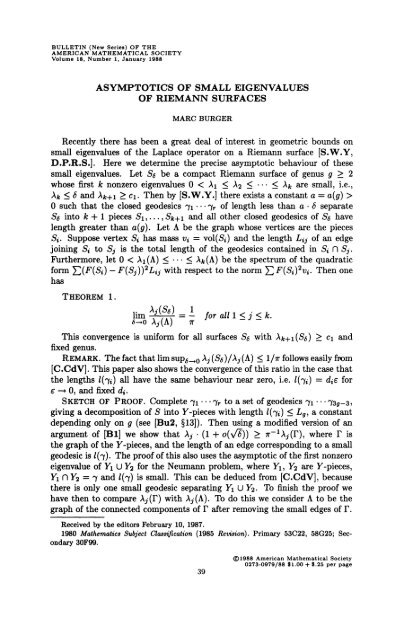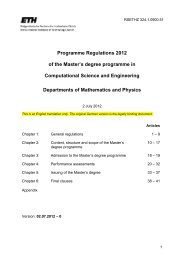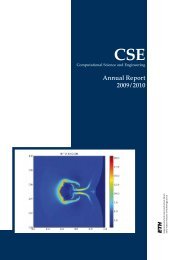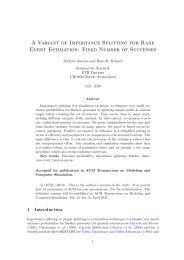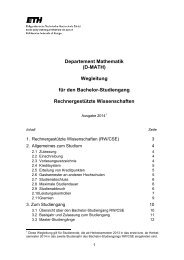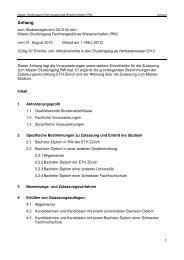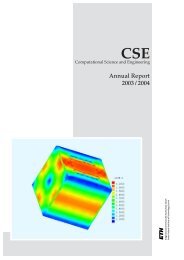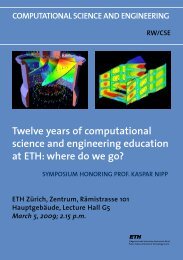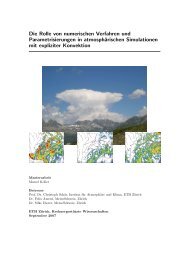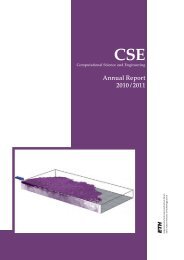Asymptotics of small eigenvalues of Riemann surfaces
Asymptotics of small eigenvalues of Riemann surfaces
Asymptotics of small eigenvalues of Riemann surfaces
Create successful ePaper yourself
Turn your PDF publications into a flip-book with our unique Google optimized e-Paper software.
BULLETIN (New Series) OF THE<br />
AMERICAN MATHEMATICAL SOCIETY<br />
Volume 18, Number 1, January 1988<br />
ASYMPTOTICS OF SMALL EIGENVALUES<br />
OF RIEMANN SURFACES<br />
MARC BURGER<br />
Recently there has been a great deal <strong>of</strong> interest in geometric bounds on<br />
<strong>small</strong> <strong>eigenvalues</strong> <strong>of</strong> the Laplace operator on a <strong>Riemann</strong> surface [S.W.Y,<br />
D.P.R.S.]. Here we determine the precise asymptotic behaviour <strong>of</strong> these<br />
<strong>small</strong> <strong>eigenvalues</strong>. Let Ss be a compact <strong>Riemann</strong> surface <strong>of</strong> genus g > 2<br />
whose first k nonzero <strong>eigenvalues</strong> 0 < Ai < À2 < • • • < Xk are <strong>small</strong>, i.e.,<br />
Xk < S and A^+i > c\. Then by [S.W.Y.] there exists a constant a = a(g) ><br />
0 such that the closed geodesies 71 • • • *> <strong>of</strong> length less than a • 6 separate<br />
Ss into A; + 1 pieces Si,..., Sfc+i and all other closed geodesies <strong>of</strong> Ss have<br />
length greater than a(g). Let A be the graph whose vertices are the pieces<br />
S{. Suppose vertex Si has mass Vi = vol(S;) and the length L^ <strong>of</strong> an edge<br />
joining S« to Sj is the total length <strong>of</strong> the geodesies contained in Si C\ Sj.<br />
Furthermore, let 0 < Ai(A) < • • • < Afc(A) be the spectrum <strong>of</strong> the quadratic<br />
form £(F(Si) - F{Sj)) 2 Lij with respect to the norm £F(S,) 2 Vi. Then one<br />
has<br />
THEOREM l.<br />
limM§) = I<br />
foralll TT~ 1 XJ(T), where T is<br />
the graph <strong>of</strong> the Y-pieces, and the length <strong>of</strong> an edge corresponding to a <strong>small</strong><br />
geodesic is /(7). The pro<strong>of</strong> <strong>of</strong> this also uses the asymptotic <strong>of</strong> the first nonzero<br />
eigenvalue <strong>of</strong> Yi U Y2 for the Neumann problem, where Yi, Y2 are Y-pieces,<br />
Yi D Y2 = 7 and Z(7) is <strong>small</strong>. This can be deduced from [C.CdV], because<br />
there is only one <strong>small</strong> geodesic separating Yi U Y2. To finish the pro<strong>of</strong> we<br />
have then to compare Xj(T) with Aj(A). To do this we consider A to be the<br />
graph <strong>of</strong> the connected components <strong>of</strong> T after removing the <strong>small</strong> edges <strong>of</strong> T.<br />
Received by the editors February 10, 1987.<br />
1980 Mathematics Subject Classification (1985 Revision). Primary 53C22, 58G25; Secondary<br />
30F99.<br />
39<br />
©1988 American Mathematical Society<br />
0273-0979/88 $1.00 + $.25 per page
40 MARC BURGER<br />
If ƒ is an eigenfunction corresponding to X 3 (T) we write ƒ = h + g, where, on<br />
each component, h is constant and g <strong>of</strong> mean zero: Applying the quadratic<br />
form to h + g we estimate the resulting terms.<br />
If one is interested in lower bounds on Xj in terms <strong>of</strong> A^(A) it is more<br />
convenient to relate Xj to a graph associated to a geodesic triangulation <strong>of</strong> S<br />
as considered in [Bui] and used in [B2, §4]. As in the pro<strong>of</strong> <strong>of</strong> Theorem 1,<br />
one relates then the spectrum <strong>of</strong> this graph to Xj(A).<br />
THEOREM 2. Let S be a compact <strong>Riemann</strong> surface <strong>of</strong> genus g > 2 and<br />
Kli) < " < Kir) < Klr+i)"' be the length <strong>of</strong> the closed geodesies <strong>of</strong><br />
length <strong>small</strong>er than 2 In 2. Then there exists a universal constant c> 0 s.t. if<br />
l(lr) < l{lr+i)/g 2 then Xj{S) > cXj(A) for 1 < j < k. And A is the graph<br />
associated to the components <strong>of</strong> S after removing the geodesies 71,..., 7 r .<br />
REMARKS, (a) It is easy to generalize Theorems 1 and 2 to the case <strong>of</strong><br />
geometrically finite <strong>surfaces</strong>.<br />
(b) In [D.P.R.S.] the inequality <strong>of</strong> Theorem 2 is stated with a constant<br />
c(g) depending on the genus <strong>of</strong> S. But for fixed g there are only finitely many<br />
graph structures which can occur if one forgets the length <strong>of</strong> the edges, thus a<br />
constant depending on g "destroys" the combinatorial information contained<br />
in Xj(A).<br />
(c) If there are no <strong>small</strong> geodesies or if the <strong>small</strong> geodesies don't disconnect<br />
the surface then Ai(5) > c/g 2 , c > 0 being a universal constant.<br />
REFERENCES<br />
[Bl] M. Burger, Estimation de petites valeurs propres du Laplacien d'un revêtement de<br />
variétés riemanniennes compactes, C.R. Acad. Sci. Paris Sér. I 302 (1986), 191-194.<br />
[B2] , Spectre du Laplacien, graphes et topologie de Fell, preprint.<br />
[Bul] P. Buser, Cubic graphs and the first eigenvalue <strong>of</strong> a <strong>Riemann</strong> surface, Math. Z. 162<br />
(1978), 87-99.<br />
[Bu2] , <strong>Riemann</strong>sche Flàchen und Langenspektrum vom trigonometrischen Standpunkt<br />
aus, Habilitât ionsschrift, Bonn, 1980.<br />
[C.CdV] B. Colbois and Y. Colin de Verdière, Sur la multiplicité de la première valeur<br />
propre d'une surface de <strong>Riemann</strong> à courbure constante, preprint.<br />
[D.P.R.S.] J. Dodziuk, T. Pignataro, B. Randol, and D. Sullivan, Estimating <strong>small</strong><br />
<strong>eigenvalues</strong> <strong>of</strong> <strong>Riemann</strong> <strong>surfaces</strong>, preprint.<br />
[S.W.Y.] R. Schoen, S. Wolpert, and S. T. Yau, Geometric bounds on low <strong>eigenvalues</strong> <strong>of</strong><br />
a compact <strong>Riemann</strong> surface, Geometry <strong>of</strong> the Laplace Operator, Proc. Sympos. Pure Math.,<br />
vol. 36, Amer. Math. Soc, Providence, R.I., 1980, pp. 279-285.<br />
MATHEMATISCHES INSTITUT, RHEINSPRUNG 21, 4051 BASEL, SWITZERLAND


